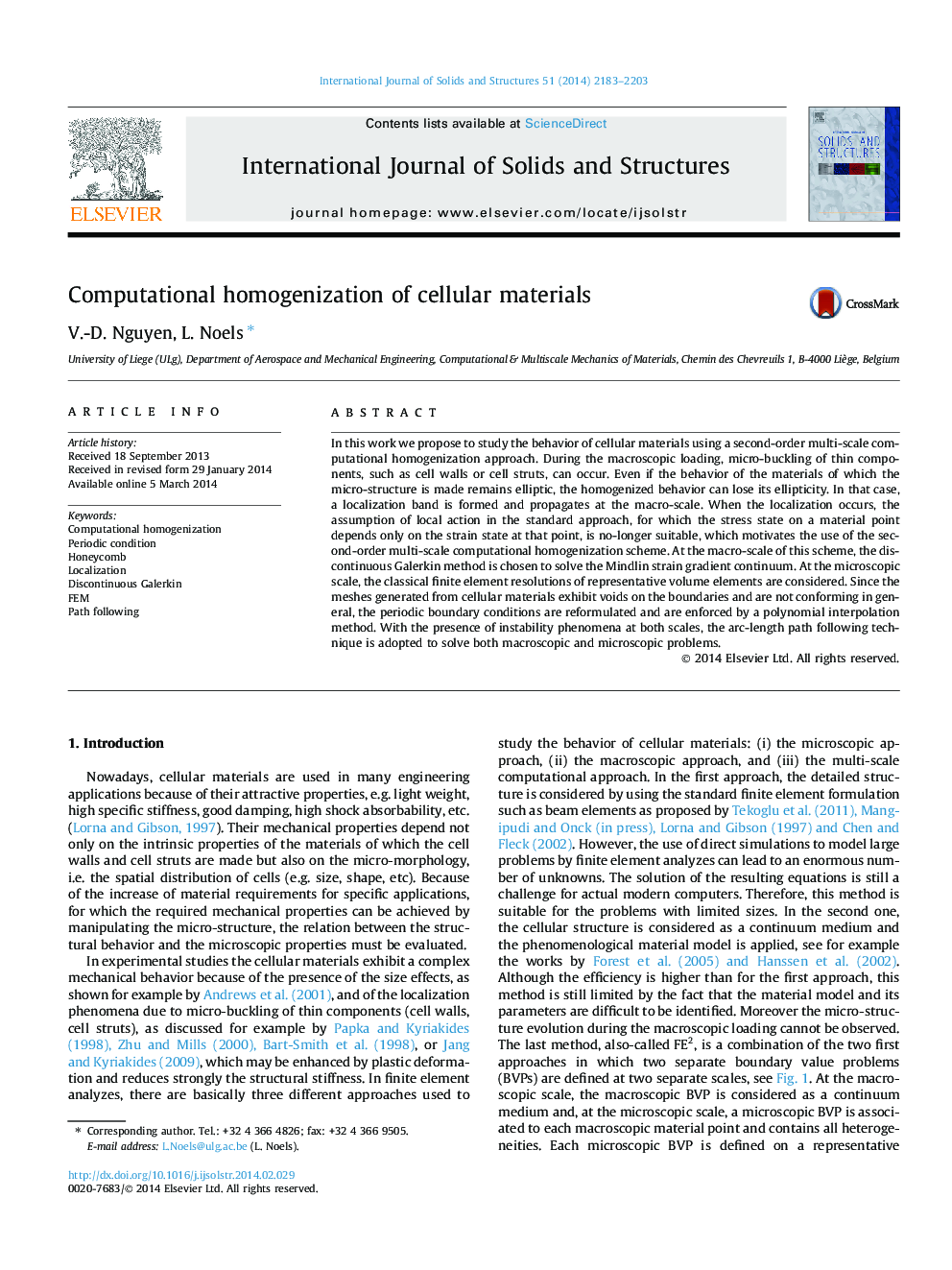| کد مقاله | کد نشریه | سال انتشار | مقاله انگلیسی | نسخه تمام متن |
|---|---|---|---|---|
| 6749125 | 1430240 | 2014 | 21 صفحه PDF | دانلود رایگان |
عنوان انگلیسی مقاله ISI
Computational homogenization of cellular materials
ترجمه فارسی عنوان
همگن سازی محاسباتی مواد سلولی
دانلود مقاله + سفارش ترجمه
دانلود مقاله ISI انگلیسی
رایگان برای ایرانیان
کلمات کلیدی
ترجمه چکیده
در این کار ما پیشنهاد می کنیم رفتار رفتار مواد سلولی را با استفاده از یک رویکرد همگن سازی محاسباتی چند منظوره دوم مرتبه انجام دهیم. در طول بارگذاری ماکروسکوپی، میکروکوباسیون اجزای نازک مانند دیواره سلولی یا ستونهای سلولی ممکن است رخ دهد. حتی اگر رفتار مواد ساخته شده از میکرو ساختار بیضی شکل باشد، رفتار همگن می تواند بیضی شکل خود را از دست بدهد. در این صورت یک گروه محلی سازی شکل گرفته و در مقیاس بزرگ به کار می رود. وقتی محلی سازی رخ می دهد، فرضیه عمل محلی در رویکرد استاندارد، که وضعیت استرس در یک نقطه ی مادی فقط در حالت کشش بستگی دارد، بیشتر مناسب نیست، که انگیزه استفاده از چندتایی مرتبه دوم طرح توزیع مجدد محاسباتی. در مقیاس کلان این طرح، روش حلقه گالککین برای حل معادله بار گرادیان میندلین انتخاب شده است. در مقیاس میکروسکوپی، قطعنامه های عناصر محدود کلاسیک عناصر حجم نمایشی در نظر گرفته می شود. از آنجایی که شبکه های تولید شده از مواد سلولی حاشیه ها را بر روی مرزها نشان می دهند و به طور کلی مطابقت ندارند، شرایط مرزی دوره ای اصلاح می شوند و با روش یکپارچه سازی چندجملهای اجرا می شوند. با وجود پدیده بی ثباتی در هر دو مقیاس، روش بعدی مسیر قوس طولی برای حل مسائل ماکروسکوپیک و میکروسکوپی اتخاذ می شود.
موضوعات مرتبط
مهندسی و علوم پایه
سایر رشته های مهندسی
مهندسی عمران و سازه
چکیده انگلیسی
In this work we propose to study the behavior of cellular materials using a second-order multi-scale computational homogenization approach. During the macroscopic loading, micro-buckling of thin components, such as cell walls or cell struts, can occur. Even if the behavior of the materials of which the micro-structure is made remains elliptic, the homogenized behavior can lose its ellipticity. In that case, a localization band is formed and propagates at the macro-scale. When the localization occurs, the assumption of local action in the standard approach, for which the stress state on a material point depends only on the strain state at that point, is no-longer suitable, which motivates the use of the second-order multi-scale computational homogenization scheme. At the macro-scale of this scheme, the discontinuous Galerkin method is chosen to solve the Mindlin strain gradient continuum. At the microscopic scale, the classical finite element resolutions of representative volume elements are considered. Since the meshes generated from cellular materials exhibit voids on the boundaries and are not conforming in general, the periodic boundary conditions are reformulated and are enforced by a polynomial interpolation method. With the presence of instability phenomena at both scales, the arc-length path following technique is adopted to solve both macroscopic and microscopic problems.
ناشر
Database: Elsevier - ScienceDirect (ساینس دایرکت)
Journal: International Journal of Solids and Structures - Volume 51, Issues 11â12, 1 June 2014, Pages 2183-2203
Journal: International Journal of Solids and Structures - Volume 51, Issues 11â12, 1 June 2014, Pages 2183-2203
نویسندگان
V.-D. Nguyen, L. Noels,
